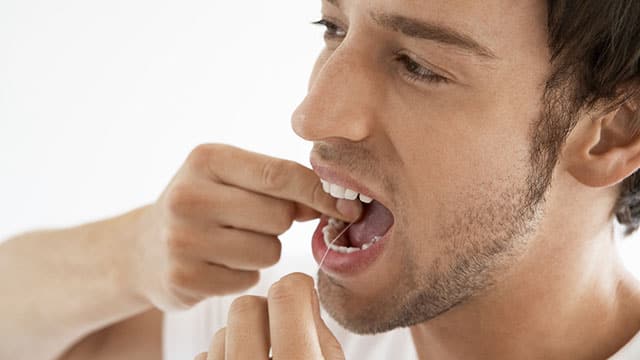What is a Water Flosser?
A water flosser or oral irrigator is a handheld device that sprays a pressurised stream of water. It typically includes a water tank and multiple pressure settings to adjust the water jet. The steady pulsating movement of water helps remove plaque from between the teeth and along the gumline. Plaque is a sticky film of bacteria and food particles that constantly forms on your teeth and gumline. Flossing prevents plaque in tight spaces from hardening into tartar and causing various oral health problems.
So, how do you floss with an oral irrigator? First, you fill the water tank of the device with fresh water. Then you may hold the jet tip of the device in your mouth above the gumline and turn it on. The flosser will spray a steady jet of water to gently clean the hard-to-reach spots.
When to Consider Using a Water Flosser
When considering how to floss teeth, a variety of methods are available. In regular flossing, a dental floss or string floss is used. You may hold it between your fingers, slide it between your teeth and move it up, down, around each tooth and under the gumline to clean those areas. However, this method requires gentle and careful movement of the hand to clean effectively without snapping the string and hurting your gums.
If you are wondering when do water flossers work, they can be helpful in some situations. Not everyone may find traditional dental floss easy. Some people may have limited hand movement due to underlying health issues. Though dentists recommend traditional flossing, oral irrigators can be a better choice in the situations mentioned below.
For Braces, Orthodontics, Bridges & Implants
If you are wondering, “Are water flossers good for braces?” the answer is yes. Cleaning dental work, such as braces, crowns, and implants, regularly is important to reduce the risk of plaque buildup and cavities. Some people may find it hard to use a string floss to clean under or around these orthodontic appliances. But an oral irrigator can help flush out food particles and plaque using the water pressure.
For dental braces: It helps soften and flush out the food debris stuck around brackets and wires, helping prevent plaque buildup. So, when considering how to floss with braces, an oral irrigator can come in handy.
For bridges & implants: Water flossing can help clean tight spaces where a dental floss cannot easily reach. Aiding in plaque removal, it can support gum health and the longevity of the implant.
Deep Cleaning
A water flosser can be helpful for deep cleaning areas in the mouth where a toothbrush or string floss may not reach easily. The pressurised water jet can reach between the hard-to-reach spaces and below the gumline to remove food debris and bacteria. This makes it a good choice for people with early signs of gum disease and deeper gum pockets.
Regular use of an oral irrigator can help reduce plaque buildup and support healthier gums and fresher breath. While it can add an extra layer of protection to your daily oral care, it should not replace proper brushing and flossing.
Difficulty Using String
Using a string floss may not be convenient for everyone alike. People with sensitive gums, limited hand mobility or conditions like arthritis may find it hard to floss properly every day. In such situations, an oral irrigator offers a simple yet effective alternative.
When considering how to floss your teeth with an oral irrigator, all you need to do is fill the water tank, hold the nozzle in the correct position and press; the water pressure will do the job. This makes it an easy and practical solution for anyone who has limited dexterity or dislikes the feel of string floss.
Sensitive or Bleeding Gums
If you have sensitive or bleeding gums, using a string floss makes you uncomfortable. It may hurt or irritate the gums, especially if you do not know how to floss properly. In such cases, an oral irrigator offers a gentle alternative. The water pressure washes away plaque without irritating the delicate gum tissues. Consistent use over time can help improve gum health and reduce bleeding.
Missed Flossing Habits
Flossing once daily is essential for good oral hygiene. However, if you have skipped flossing for a long time, an oral irrigator can help you get back on track. Unlike string floss, which needs care and effort, it is quick, gentle and simple to use. It helps you to build a daily flossing habit. Even if you have struggled with consistency in the past, oral irrigators help make flossing less of a chore and more of a fun and effective dental care routine.
Top Benefits of Water Flossing
If you are wondering why use water flosser over traditional dental floss, the answer lies in its unique benefits. Besides convenience, the best water flosser offers an effective way to maintain a cleaner and healthier mouth. Its key benefits include:
Gentle on the gums: Oral irrigators are a good alternative to string floss for people with bleeding or sensitive gums. They clean along the gumline without hurting the soft gum tissues.
Effective cleaning: The water jet can reach tight spaces between teeth and below the gumline where the toothbrush and string floss may not.
Adjustable pressure: Most oral irrigators come with multiple pressure settings. You can adjust the force of the water jet, making it comfortable for people with sensitive teeth. High-pressure mode may suit people without sensitivity who need a deeper cleansing, especially if they have not been flossing regularly.
Targeted cleaning: You can aim the water jet or nozzle towards specific areas below the gumline or between teeth for a targeted cleaning.
Portable options: Portable water flossers help you maintain your daily flossing habit no matter where you go, unlike countertop models. They are cordless water flossers that often include a rechargeable battery and multiple flossing modes. Portability helps you stick to the flossing routine amidst a busy schedule.
Ideal for dental work: Oral irrigators help clean around wires, bridges and implants, helping keep them clean and reducing the risk of decay.
Helps you stay consistent: For anyone who finds it hard to use dental floss, an oral irrigator is a good alternative to help you keep up with the habit of regular flossing at home or on the go.
Refreshes your breath: An oral irrigator helps flush out plaque and odour-causing bacteria trapped in hard-to-reach areas. This helps keep your mouth fresh and clean.
Pairing it with daily brushing (twice) and rinsing with a mouthwash can promote good oral health.
How to Use a Water Flosser Effectively
To get the most out of a water flossing routine, knowing how to use water flosser correctly is the key. The process is simple and takes only a few minutes. You may consider the following steps:
Fill the water tank with water (lukewarm for extra comfort).
Oral irrigators often come with multiple floss tips, such as orthodontic or classic jet. Choose a floss tip comfortable for you and place it on the handle properly.
Set the pressure or flossing mode. Ideally, start with low-pressure settings, especially if you have sensitive gums, and vary it gradually.
Lean over the sink to prevent splashing. Hold the floss tip in your mouth at an angle of 90 degrees towards the gumline, and turn it on.
Clean all areas, starting with your back teeth on both jaws and bring the floss tip forward. Pausing briefly between the teeth, trace the gumline with the tip in contact with the tooth and the gumline.
Make sure to floss the inner and outer surfaces of teeth as well as between teeth. Continue until you are done cleaning all teeth.
Empty the tank and rinse the floss tip. Rinse and clean any removable parts of the device and store them in a neat and dry place.
Water Flosser vs. Traditional Dental Floss
Both water flossers and traditional dental floss serve the same purpose of plaque removal from hard-to-reach areas in the mouth. However, they work in different ways. Understanding water flossing vs traditional flossing can help you decide what method suits you the most.
Traditional Floss: It requires the use of a string floss and dexterity of the hands to work well. It is effective to remove plaque directly from the tooth surface and along the gumline. However, people with braces, bridges or implants may find it hard to use it for effective cleaning.
Water Flosser: It uses a pressurised jet stream of water for plaque removal from interdental gaps and below the gumline. It is gentle on the gums and is easier for people with dental work, sensitive gums or sensitive teeth.
However, it is vital to note that dentists often recommend traditional flossing. An oral irrigator is a complement, rather than a replacement, for regular string floss. Together, they can provide the most thorough cleaning your teeth and gums deserve.
Water flossing offers a simple yet effective way to improve your dental care routine. Though it is not a replacement for string floss, it can make flossing fun and more comfortable. Whether you are struggling with sensitivity or have dental work on your teeth, a water flosser can help you maintain the habit of interdental cleaning every day. Adding an oral irrigator to your oral care routine can be a smart way to achieve healthier gums and cleaner teeth for a healthy smile.
Frequently Asked Questions
Is it good to use a water flosser?
Yes, it removes plaque from between teeth and along the gumline. It is gentle and cleanses your mouth effectively while complementing brushing, traditional flossing and rinsing.Can water flosser damage gums?
No, it does not harm the gums when used correctly. Oral irrigators use a pressurised water jet that is gentle on your teeth and gums. Ideally, start with a low-pressure setting if you have a sensitive mouth.Should I use a water flosser before or after brushing?
You may use it either way. Using it before brushing may help loosen the food debris and plaque, aiding in better cleaning.When should I start using a water flosser?
You may start using it anytime. It particularly helps if you have dental implants, braces, sensitive gums or gum problems, or are struggling to use a regular dental floss.










